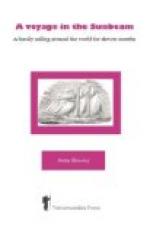On my way from the station to the house, going over the Satinwood Bridge, from which there is a lovely view of the Peacock Mountain, I saw an Englishman whom we had observed before, washing stones in the bed of the river for gems. He has obtained some rubies and sapphires, though only of small size, and I suppose he will go on washing for ever, hoping to find something larger and more valuable. On one part of the coast of the island near Managgan the sands on the side of one of the rivers are formed of rubies, sapphires, garnets, and other precious stones washed down by the current, but they are all ground to pieces in the process, not one being left as big as a pin’s head. The effect in the sunlight, when this sand is wet with the waves, is something dazzling, and proves that the accounts of my favourite Sindbad are not so fabulous as we prosaic mortals try to make out. The island must be rich in gems, for they seem to be picked up with hardly any trouble. At Neuera-ellia it is a favourite amusement for picnic parties to go out gem-hunting, and frequently they meet with very large and valuable stones by the riverside or near deserted pits, large garnets, cinnamon-stone, splendid cat’s-eyes, amethysts, matura diamonds, moonstone, aquamarine, tourmaline rubies, and sapphires.
[Illustration: Peacock Mountain, Ceylon.]
On my arrival at the house I found that Mabelle had just returned with some friends, who had kindly taken charge of her during our absence, and that a very old friend had arrived almost directly we left on Monday, and had departed early this morning to climb Adam’s Peak, the ascent of which is a long and tedious affair, but it cannot be difficult, as thousands of aged and infirm pilgrims go every year to worship at the Buddhist or Mohammedan temples at the summit. The giant footprint has been reverenced alike by both religions from the earliest ages. Its existence is differently accounted for, however, by the two sects. The Buddhists say it is the footprint of Buddha, and that an account of its origin was written 300 or 400 years B.C. The Mohammedans say that it is the first step Adam took when driven out of Paradise. They do not quarrel about it, however, but live very happily close beside one another in their respective temples on the very small summit of the mountain. The iron chains, still used by the pilgrims and visitors to assist them up the last weary flight of steps, are said to have been placed there in the time of Alexander the Great, and are mentioned by successive historians.
After lunch I went to rest, thoroughly tired out with the hard work of the last two days, whilst the gentlemen went into Kandy, to see Buddha’s tooth and a Brahmin temple.




